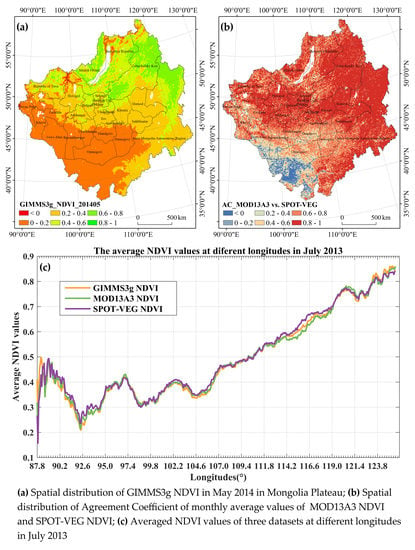Intercomparison of AVHRR GIMMS3g, Terra MODIS, and SPOT-VGT NDVI Products over the Mongolian Plateau
Abstract
1. Introduction
2. Materials and Methods
2.1. Study Area
2.2. Datasets
2.2.1. NDVI Datasets
2.2.2. Land Cover
2.2.3. Terrestrial Ecoregions
2.2.4. The Landsat Image
2.3. Methods
2.3.1. Agreement Coefficient
2.3.2. Decompose Analysis
2.3.3. Spatial Statistical Analysis
3. Results
3.1. Spatial Consistency Characteristics
3.1.1. Overall Spatial Patterns
3.1.2. Spatial Zonality of Terrestrial Ecoregions
- (1)
- The biome of montane grasslands and shrublands centrally locate in the southern region of the IMAR and sporadically distribute in Western Mongolia and southwestern regions of Lake Baikal. The main land cover types in this biome are closed to open herbaceous vegetation, including grassland, savannas, and shrublands, according to the ESA GlobCover 2009 map. The largest AC values between GIMMS3g NDVI and SPOT-VGT NDVI in this biome indicate that the correlation between GIMMS3g NDVI and SPOT-VGT NDVI is higher than other combinations in the biome of montane grasslands and shrublands. Meanwhile, the smallest mean MBE values between GIMMS3g NDVI and MOD13A3 NDVI indicate that GIMMS3g NDVI values has a closer average and discrete degree to MOD13A3 NDVI than other combinations in the biome of montane grasslands and shrublands.
- (2)
- The biome of temperate conifer forests mainly locates in the northeastern IMAR, the western border area of Mongolia, the northern part of the Republic of Tuva of Russia, and the Mongolia–Russia border area in the southwest of Lake Baikal. The main types of land cover in the biome are open needleleaved deciduous and evergreen forest. Similarly, the largest AC values between GIMMS3g NDVI and SPOT-VGT NDVI reflect higher consistency of the two datasets in this biome, and the smallest MBE values between GIMMS3g NDVI and MOD13A3 NDVI explain higher proximity in the biome of temperate conifer forests.
- (3)
- The boreal forest/taiga biome, covered with open needleleaved deciduous and evergreen forest, mainly locates in Zabaykalsky Krai, Buryatia Republic, and Irkutsk Oblast in Russia. Because of high evergreen vegetation coverage, the three NDVI datasets have quite high consistency. The largest AC values between GIMMS3g NDVI and SPOT-VGT NDVI in this biome with the smallest STD indicate higher agreement of GIMMS3g NDVI and SPOT-VGT NDVI.
- (4)
- The biome of temperate grasslands, savannas, and shrublands mainly distributes in the north and east parts of Mongolia and the central part of IMAR, which is the largest biome in the study region, with an area exceeding one third of the MP. The land covers of this biome are mainly mosaic vegetation of grasslands, shrublands, forests, and some croplands. The largest AC values are presented between GIMMS3g NDVI and SPOT-VGT NDVI in this biome and the smallest MBE occurs in the combination of GIMMS3g NDVI and MOD13A3 NDVI.
- (5)
- The biome of deserts and xeric shrublands mainly locate in Western and Southern Mongolia, and northwestern IMAR, with dominant land covers of desert and bare areas. Because of very low vegetation coverage, the NDVI values of the three datasets vary differently. Compared with other biomes, the consistency of the three NDVI products in the biome of deserts and xeric shrublands are quite low. The highest average AC value between MOD13A3 NDVI and SPOT-VGTNDVI indicates that the dataset combinations with higher resolution, such as MOD13A3 NDVI and SPOT-VGT NDVI, have higher consistency in desert and bare land in the southwest of the MP.
- (6)
- The biome of temperate broadleaf and mixed forests in the eastern IMAR is mainly covered by mosaic vegetation of shrublands, and needleleaved deciduous and evergreen forests. Just like most biomes in the MP, GIMMS3g NDVI and SPOT-VGT NDVI have the largest AC value and the smallest STD of MBE values in the biome of temperate broadleaf and mixed forests.
- (7)
- Tundra is the smallest biome in the MP, which is mainly covered by intersection of open needleleaved deciduous and evergreen forest and bare areas. Because of near space position with the biome of boreal forest/taiga, the largest AC values similarly occur in the combination of GIMMS3g NDVI and SPOT-VGT NDVI in the biome of tundra. Meanwhile, the negative mean MBE value in the biome of tundra indicates that the values of GIMMS3g NDVI are essentially smaller than MOD13A3 NDVI in the northern region of Zabaykalsky Krai and Buryatia Republic in Russia.
3.2. Temporal Variability Characteristics
3.2.1. Overall Temporal Variations
3.2.2. Temporal Zonality of Terrestrial Ecoregions
- (1)
- Based on Figure 7a, the average values of deseasonalized NDVI in the biome of montane grasslands and shrublands range from 0.11 to 0.25, showing an upward trend of fluctuation. SPOT-VGT NDVI values are about 0.02 lower than the other two NDVI datasets in the whole periods. GIMMS3g NDVI shares very close variation characteristics with MOD13A3 NDVI values, in which the GIMMS3g NDVI values are lower than MOD13A3 NDVI values before 2002, but MOD13A3 NDVI values are higher from 2003.
- (2)
- Figure 7b demonstrates the deseasonalized NDVI values in the biome of temperate conifer forests. The average NDVI values in this biome range from 0.23 to 0.41 with obvious fluctuation in the whole interval, and the difference between SPOT-VGT NDVI values and the other two datasets in the biome is about 0.04. Compared with MOD13A3 NDVI, the GIMMS3g NDVI values have smaller fluctuation amplitude, which indicates that GIMMS3g NDVI values are less discrete.
- (3)
- As shown in Figure 7c, the NDVI values in the biome of boreal forest/taiga range from 0.23 to 0.53, which is the largest amplitude in all seven biomes. At the same time, the SPOT-VGT NDVI values have the largest differences with GIMMS3g NDVI and MOD13A3 NDVI values in the biome of boreal forest/taiga.
- (4)
- Figure 7d shows the average off-season NDVIs in the biome of temperate grasslands, savannas, and shrublands. As the largest biome in the study region, the differences between SPOT-VGT NDVI values and the other two NDVI datasets in this biome are lower than in the other biomes, and the fluctuation characteristics of the three datasets are relatively consistent, especially in the performance of outliers. In July 2007, all three NDVI data showed abnormally low values in the biome of temperate grasslands, savannas, and shrublands, which can probably be related to the cooling effects caused by the La Niña occurring in 2007.
- (5)
- The average values of deseasonalized NDVI in the biome of deserts and xeric shrublands are shown in Figure 7e. The NDVI values in this biome vary, with the smallest amplitude due to very little vegetation cover. The three datasets come the closest to each other in this biome, which indicates that the three datasets have good consistency in temporal variation in low vegetation coverage area in the southwestern MP.
- (6)
- As shown in Figure 7f, the NDVI values in the biome of temperate broadleaf and mixed forests in the eastern IMAR have an upward trend as a whole. The consistencies of the three datasets are fairly good in this biome, and the differences between SPOT-VGT NDVI values and the other two datasets shrink with the passage of years. In addition, the values of MOD13A3 NDVI are generally higher than GIMMS3g NDVI after 2002 in the biome of temperate broadleaf and mixed forests. However, in December 2012, all three NDVI datasets show abnormally low values in the east of the IMAR, which is likely to be closely related to the extreme low temperature in winter caused by the Arctic Oscillation in 2012.
- (7)
- Figure 7g shows the deseasonalized NDVI values of the biome of tundra, as the smallest biome in the MP, and the variation characteristics of NDVI values in this biome are quite similar to the biome of boreal forest/taiga. The SPOT-VGT NDVI values are significantly lower than the other two NDVI products, and the MOD13A3 NDVI values in this biome have the most obvious fluctuation variation, indicating that it has the highest sensitivity to surface vegetation cover in the biome of tundra in the northern MP.
3.3. Zonal Characteristics of NDVI Variation
3.3.1. Longitudinal and Latitudinal Zonality
3.3.2. Elevation Effects
4. Discussion
4.1. Validation against Landsat-Based NDVI
4.2. Influencing Factors of NDVI Consistency
5. Conclusions
Author Contributions
Funding
Conflicts of Interest
References
- Cao, M.; Woodward, F.I. Dynamic responses of terrestrial ecosystem carbon cycling to global climate change. Nature 1998, 393, 249–252. [Google Scholar] [CrossRef]
- Fan, L.; Gao, Y.; Brück, H.; Bernhofer, C. Investigating the relationship between NDVI and LAI in semi-arid grassland in Inner Mongolia using in-situ measurements. Theor. Appl. Climatol. 2009, 95, 151–156. [Google Scholar] [CrossRef]
- Yuhas, A.N.; Scuderi, L.A. MODIS—Derived NDVI characterisation of drought—Induced evergreen dieoff in Western North America. Geogr. Res. 2010, 47, 34–45. [Google Scholar] [CrossRef]
- Li, M.; Wu, B.; Yan, C.; Zhou, W. Estimation of vegetation fraction in the upper basin of Miyun Reservoir by remote sensing. Resour. Sci. 2004, 26, 153–159. [Google Scholar]
- Bannari, A.; Morin, D.; Bonn, F.; Huete, A.R. A review of vegetation indices. Remote Sens. Rev. 1995, 13, 95–120. [Google Scholar] [CrossRef]
- Guo, N. Vegetation Index and Its Advances. J. Arid Meteorol. 2003, 21, 71–75. [Google Scholar]
- Guo, N.; Yang, L.; Wang, J. A Study of Ecological Environment in Heihe Valley Area through Meteorology Satellite Monitoring. Plateau Meteorol. 2002, 21, 267–273. [Google Scholar]
- Roerink, G.J.; Menenti, M.; Soepboer, W.; Su, Z. Assessment of climate impact on vegetation dynamics by using remote sensing. Phys. Chem. Earth 2002, 28, 103–109. [Google Scholar] [CrossRef]
- Landmann, T.; Schramm, M.; Huettich, C.; Dech, S. MODIS-based change vector analysis for assessing wetland dynamics in Southern Africa. Remote Sens. Lett. 2013, 4, 104–113. [Google Scholar] [CrossRef]
- Price, J.C. Using spatial context in satellite data to infer regional scale evapotranspiration. IEEE Trans. Geosci. Remote Sens. 1990, 28, 940–948. [Google Scholar] [CrossRef]
- Carlson, T.N.; Gillies, R.R.; Perry, E.M. A Method to Make Use of Thermal Infrared Temperature and NDVI measurements to Infer Surface Soil Water Content and Fractional Vegetation Cover. Remote Sens. Rev. 1994, 9, 161–173. [Google Scholar] [CrossRef]
- Anyamba, A.; Tucker, C.J. Analysis of Sahelian vegetation dynamics using NOAA-AVHRR NDVI data from 1981–2003. J. Arid Environ. 2005, 63, 596–614. [Google Scholar] [CrossRef]
- Moulin, S.; Kergoat, L.; Viovy, N.; Dedieu, G. Global-Scale Assessment of Vegetation Phenology Using NOAA/AVHRR Satellite Measurements. J. Clim. 1995, 10, 1154–1170. [Google Scholar] [CrossRef]
- Xin, J.; Yu, Z.; Leeuwen, L.V.; Driessen, P.M. Mapping crop key phenological stages in the North China Plain using NOAA time series images. Int. J. Appl. Earth Obs. Geoinf. 2003, 4, 109–117. [Google Scholar] [CrossRef]
- Hermance, J.F.; Jacob, R.W.; Bradley, B.A.; Mustard, J.F. Extracting Phenological Signals from Multiyear AVHRR NDVI Time Series: Framework for Applying High-Order Annual Splines with Roughness Damping. IEEE Trans. Geosci. Remote Sens. 2007, 45, 3264–3276. [Google Scholar] [CrossRef]
- Duarte, L.; Teodoro, A.C.; Monteiro, A.T.; Cunha, M.; Gonçalves, H. QPhenoMetrics: An open source software application to assess vegetation phenology metrics. Comput. Electron. Agric. 2018, 148, 82–94. [Google Scholar] [CrossRef]
- Chen, X.; Tan, Z.; Schwartz, M.D.; Xu, C. Determining the growing season of land vegetation on the basis of plant phenology and satellite data in Northern China. Int. J. Biometeorol. 2000, 44, 97–101. [Google Scholar] [CrossRef]
- Bradley, B.A.; Jacob, R.W.; Hermance, J.F.; Mustard, J.F. A curve fitting procedure to derive inter-annual phenologies from time series of noisy satellite NDVI data. Remote Sens. Environ. 2007, 106, 137–145. [Google Scholar] [CrossRef]
- Zhang, G.; Zhang, Y.; Dong, J.; Xiao, X. Green-up dates in the Tibetan Plateau have continuously advanced from 1982 to 2011. Proc. Natl. Acad. Sci. USA 2013, 110, 4309–4314. [Google Scholar] [CrossRef]
- Jeong, S.J.; Ho, C.H.; Brown, M.E.; Kug, J.S.; Piao, S. Browning in desert boundaries in Asia in recent decades. J. Geophys. Res. Atmos. 2011, 116, 1–7. [Google Scholar] [CrossRef]
- Waweru, M.N.; Jahjah, M.; Laneve, G. Spatial change analysis using temporal remote sensing and ancillary data for desertification change detection. Proc. SPIE Int. Soc. Opt. Eng. 2004, 5239, 345–356. [Google Scholar]
- Saito, H.; Sawada, Y.; Furuya, N.; Preap, S. Land Cover Change Mapping of the Mekong River Basin Using NOAA Pathfinder AVHRR 8-km Land Dataset; Springer: New York, NY, USA, 2007. [Google Scholar]
- Brown, J.C.; Kastens, J.H.; Coutinho, A.C.; de Castro Victoria, D.; Bishop, C.R. Classifying multiyear agricultural land use data from Mato Grosso using time-series MODIS vegetation index data. Remote Sens. Environ. 2013, 130, 39–50. [Google Scholar] [CrossRef]
- Gopal, S.; Woodcock, C.E.; Strahler, A.H. Fuzzy Neural Network Classification of Global Land Cover from a 1° AVHRR Data Set. Remote Sens. Environ. 1999, 67, 230–243. [Google Scholar] [CrossRef]
- Hill, M.J.; Vickery, P.J.; Furnival, E.P.; Donald, G.E. Pasture Land Cover in Eastern Australia from NOAA-AVHRR NDVI and Classified Landsat TM. Remote Sens. Environ. 1999, 67, 32–50. [Google Scholar] [CrossRef]
- Pan, Y.; Li, X.; Gong, P.; He, C.; Shi, P.; Pu, R. An integrative classification of vegetation in China based on NOAA AVHRR and vegetation-climate indices of the Holdridge life zone. Int. J. Remote Sens. 2003, 24, 1009–1027. [Google Scholar] [CrossRef]
- Bisson, M.; Fornaciai, A.; Coli, A.; Mazzarini, F.; Pareschi, M.T. The Vegetation Resilience after Fire (VRAF) index: Development, implementation and an illustration from central Italy. Int. J. Appl. Earth Obs. Geoinf. 2008, 10, 312–329. [Google Scholar] [CrossRef]
- Chuvieco, E.; Martín, M.P.; Palacios, A. Assessment of different spectral indices in the red-near-infrared spectral domain for burned land discrimination. Int. J. Remote Sens. 2002, 23, 5103–5110. [Google Scholar] [CrossRef]
- Escuin, S.; Navarro, R.; Fernández, P. Fire severity assessment by using NBR (Normalized Burn Ratio) and NDVI (Normalized Difference Vegetation Index) derived from LANDSAT TM/ETM images. Int. J. Remote Sens. 2008, 29, 21. [Google Scholar] [CrossRef]
- John, R.; Chen, J.; Ouyang, Z.T.; Xiao, J.; Becker, R.; Samanta, A.; Ganguly, S.; Yuan, W.; Batkhishig, O. Vegetation response to extreme climate events on the Mongolian Plateau from 2000 to 2010. Environ. Res. Lett. 2013, 8, 035033. [Google Scholar] [CrossRef]
- Bunkei, M.; Wei, Y.; Jin, C.; Yuyichi, O.; Guoyu, Q. Sensitivity of the Enhanced Vegetation Index (EVI) and Normalized Difference Vegetation Index (NDVI) to Topographic Effects: A Case Study in High-density Cypress Forest. Sensors 2007, 7, 2636–2651. [Google Scholar]
- Jiang, Z.; Huete, A.R.; Didan, K.; Miura, T. Development of a two-band enhanced vegetation index without a blue band. Remote Sens. Environ. 2008, 112, 3833–3845. [Google Scholar] [CrossRef]
- Chu, H.; Venevsky, S.; Wu, C.; Wang, M. NDVI-based vegetation dynamics and its response to climate changes at Amur-Heilongjiang River Basin from 1982 to 2015. Sci. Total Environ. 2019, 650, 2051–2062. [Google Scholar] [CrossRef] [PubMed]
- Zheng, K.; Wei, J.; Pei, J.; Cheng, H.; Zhang, X.; Huang, F.; Li, F.; Ye, J. Impacts of climate change and human activities on grassland vegetation variation in the Chinese Loess Plateau. Sci. Total Environ. 2019, 660, 236–244. [Google Scholar] [CrossRef] [PubMed]
- Gu, Y.; Wylie, B.K.; Howard, D.M.; Phuyal, K.P.; Lei, J.I. NDVI saturation adjustment: A new approach for improving cropland performance estimates in the Greater Platte River Basin, USA. Ecol. Indic. 2013, 30, 1–6. [Google Scholar] [CrossRef]
- Du, J.Q.; Shu, J.M.; Wang, Y.H.; Li, Y.C.; Yang, G. Comparison of GIMMS and MODIS normalized vegetation index composite data for Qinghai-Tibet Plateau. Chin. J. Appl. Ecol. 2014, 25, 533. [Google Scholar]
- Fensholt, R.; Proud, S.R. Evaluation of Earth Observation based global long term vegetation trends- Comparing GIMMS and MODIS global NDVI time series. Remote Sens. Environ. 2012, 119, 131–147. [Google Scholar] [CrossRef]
- Hou, M.; Zhao, H.; Wang, Z.; Yan, X. Comparison of GIMMS, VGT and MODIS Vegetation Index Datasets in Eastern China. Remote Sens. Technol. Appl. 2013, 28, 290–299. [Google Scholar]
- Zhou, X.; Yamaguchi, Y.; Arjasakusuma, S. Distinguishing the vegetation dynamics induced by anthropogenic factors using vegetation optical depth and AVHRR NDVI: A cross-border study on the Mongolian Plateau. Sci. Total Environ. 2018, 616–617, 730–743. [Google Scholar] [CrossRef]
- Suzuki, R.; Masuda, K.; Dye, D.G. Interannual covariability between actual evapotranspiration and PAL and GIMMS NDVIs of northern Asia. Remote Sens. Environ. 2007, 106, 387–398. [Google Scholar] [CrossRef]
- Ibrahim, Y.Z.; Balzter, H.; Kaduk, J.; Tucker, C.J. Land Degradation Assessment Using Residual Trend Analysis of GIMMS NDVI3g, Soil Moisture and Rainfall in Sub-Saharan West Africa from 1982 to 2012. Remote Sens. 2015, 7, 5471–5494. [Google Scholar] [CrossRef]
- Meng, D.; Xiaojuan, L.I.; Gong, H.; Yiting, Q.U. Analysis of Spatial-Temporal Change of NDVI and Its Climatic Driving Factors in Beijing-Tianjin-Hebei Metropolis Circle from 2001 to 2013. J. Geo-Inf. Sci. 2015, 17, 1001–1007. [Google Scholar]
- Bilal, M.; Nichol, J.E. Evaluation of the NDVI-Based Pixel Selection Criteria of the MODIS C6 Dark Target and Deep Blue Combined Aerosol Product. IEEE J. Sel. Top. Appl. Earth Obs. Remote Sens. 2017, 10, 3448–3453. [Google Scholar] [CrossRef]
- Miao, L.; Jiang, C.; Xue, B.; Liu, Q.; He, B.; Nath, R.; Cui, X. Vegetation dynamics and factor analysis in arid and semi-arid Inner Mongolia. Environ. Earth Sci. 2015, 73, 2343–2352. [Google Scholar] [CrossRef]
- Chang, N.-B. Using SPOT-VGT NDVI as a successive ecological indicator for understanding the environmental implications in the Tarim River Basin, China. J. Appl. Remote Sens. 2010, 4, 844–862. [Google Scholar] [CrossRef]
- Hou, X.; Gao, S.; Niu, Z.; Xu, Z. Extracting grassland vegetation phenology in North China based on cumulative SPOT-VEGETATION NDVI data. Int. J. Remote Sens. 2014, 35, 3316–3330. [Google Scholar] [CrossRef]
- Beck, H.E.; McVicar, T.R.; van Dijk, A.I.; Schellekens, J.; de Jeu, R.A.; Bruijnzeel, L.A. Global evaluation of four AVHRR-NDVI data sets: Intercomparison and assessment against Landsat imagery. Remote Sens. Environ. 2011, 115, 2547–2563. [Google Scholar] [CrossRef]
- Gallo, K.; Lei, J.; Reed, B.; Eidenshink, J.; Dwyer, J. Multi-platform comparisons of MODIS and AVHRR normalized difference vegetation index data. Remote Sens. Environ. 2005, 99, 221–231. [Google Scholar] [CrossRef]
- Fensholt, R.; Rasmussen, K.; Nielsen, T.T.; Mbow, C. Evaluation of earth observation based long term vegetation trends—Intercomparing NDVI time series trend analysis consistency of Sahel from AVHRR GIMMS, Terra MODIS and SPOT VGT data. Remote Sens. Environ. 2009, 113, 1886–1898. [Google Scholar] [CrossRef]
- Song, F.; Kang, M.; Yang, P.; Chen, Y.; Liu, Y.; Xing, K. Comparison and validation of GIMMS, SPOT-VGT and MODIS global NDVI products in the Loess Plateau of northern Shaanxi Province, northwestern China. J. Beijing For. Univ. 2010, 32, 78–86. [Google Scholar]
- Bao, G.; Bao, Y.; Qin, Z.; Zhou, Y.; Adiya, S. Vegetation Cover Changes in Mongolian Plateau and Its Response to Seasonal Climate Changes in Recent 10 Years. Sci. Geogr. Sin. 2013, 33, 613–621. [Google Scholar]
- Wang, L.; Zhen, L.; Liu, X.; Batkhishig, O.; Wang, Q. Comparative studies on climate changes and influencing factors in central Mongolian Plateau Region. Geogr. Res. 2008, 27, 171–180. [Google Scholar]
- Zhou, X.; Shi, H.; Wang, X.; Meng, F. Study on the temporal and spatial dynamic changes of land use and driving forces analysis of Mongolia Plateau in recent 30 years. Acta Agric. Zhejiangensis 2012, 24, 0–1110. [Google Scholar]
- Du, J.; Kimball, J.S.; Galantowicz, J.; Kim, S.B.; Chan, S.K.; Reichle, R.; Jones, L.A.; Watts, J.D. Assessing global surface water inundation dynamics using combined satellite information from SMAP, AMSR2 and Landsat. Remote Sens. Environ. 2018, 213, 1–17. [Google Scholar] [CrossRef] [PubMed]
- GLOBCOVER 2009: Products Description and Validation Report. Available online: http://due.esrin.esa.int/files/GLOBCOVER2009_Validation_Report_2.2.pdf (accessed on 28 August 2019).
- Niu, Z.; Shan, Y.; Zhang, H. Accuracy assessment of wetland categories from the GlobCover2009 data over China. Wetl. Sci. 2012, 10, 389–395. [Google Scholar]
- Olson, D.M.; Dinerstein, E.; Wikramanayake, E.D.; Burgess, N.D.; Powell, G.V.N.; Underwood, E.C.; D’Amico, J.A.; Itoua, I.; Strand, H.E.; Morrison, J.C. Terrestrial Ecoregions of the World: A New Map of Life on Earth. Bioscience 2001, 51, 933–938. [Google Scholar] [CrossRef]
- Roy, D.P.; Wulder, M.A.; Loveland, T.R.; Woodcock, C.E.; Allen, R.G.; Anderson, M.C.; Helder, D.; Irons, J.R.; Johnson, D.M.; Kennedy, R. Landsat-8: Science and product vision for terrestrial global change research. Remote Sens. Environ. 2014, 145, 154–172. [Google Scholar] [CrossRef]
- Rouse, J.W.; Haas, R.H.; Schell, J.A.; Deering, D.W. Monitoring Vegetation Systems in the Great Plains with ERTS. In Third Earth Resources Technology Satellite-1 Symposium; Freden, S.C., Mercanti, E.P., Becker, M.A., Eds.; University of California Libraries: Berkeley, CA, USA, 1974. [Google Scholar]
- Ji, L.; Gallo, K. An Agreement Coefficient for Image Comparison. Photogramm. Eng. Remote Sens. 2015, 73, 823–833. [Google Scholar] [CrossRef]
- Jing, W.; Zhang, P.; Zhao, X. A comparison of different GRACE solutions in terrestrial water storage trend estimation over Tibetan Plateau. Sci. Rep. 2019, 9, 1765. [Google Scholar] [CrossRef]
- Andrew, R.; Guan, H.; Batelaan, O. Estimation of GRACE Water Storage Components by Temporal Decomposition. J. Hydrol. 2017, 552, 341–350. [Google Scholar] [CrossRef]
- Verbesselt, J.; Zeileis, A.; Herold, M. Near real-time disturbance detection using satellite image time series. Remote Sens. Environ. 2012, 123, 98–108. [Google Scholar] [CrossRef]
- Bai, Y.; Wang, J.; Wang, Y.; Han, X.; Tsydypov, B.Z.; Ochir, A.; Davaasuren, D. Spatio-Temporal Distribution of Drought in the Belt and Road Area During 1998–2015 Based on TRMM Precipitation Data. J. Resour. Ecol. 2017, 8, 559–570. [Google Scholar]
- Lu, H.; Raupach, M.R.; Mcvicar, T.R.; Barrett, D.J. Decomposition of vegetation cover into woody and herbaceous components using AVHRR NDVI time series. Remote Sens. Environ. 2003, 86, 1–18. [Google Scholar] [CrossRef]
- Kendall, M.G. The Advanced Theory of Statistics; Charles Griffin and Co., Ltd.: London, UK, 1946. [Google Scholar]
- Bao, G.; Qin, Z.H.; Bao, Y.H.; Zhou, Y. Spatial-temporal Changes of Vegetation Cover in Mongolian Plateau during 1982—2006. J. Desert Res. 2013, 33, 918–927. [Google Scholar]
- Dymond, C.C.; Johnson, E.A. Mapping vegetation spatial patterns from modeled water, temperature and solar radiation gradients. ISPRS J. Photogramm. Remote Sens. 2002, 57, 69–85. [Google Scholar] [CrossRef]
- Hu, S.; Zhao, R.; Jia, Y.; Niu, C.; Liu, L.; Zhan, C. The characteristic of vegetation vertical zonality and the influential factors in typical mountains in China. Chin. J. Nat. 2018, 40, 12–16. [Google Scholar]
- Ahl, D.E.; Gower, S.T.; Burrows, S.N.; Shabanov, N.V.; Myneni, R.B.; Knyazikhin, Y. Monitoring spring canopy phenology of a deciduous broadleaf forest using MODIS. Remote Sens. Environ. 2006, 104, 88–95. [Google Scholar] [CrossRef]
- Liu, Z.; Wu, C.; Liu, Y.; Wang, X.; Fang, B.; Yuan, W.; Ge, Q. Spring green-up date derived from GIMMS3g and SPOT-VGT NDVI of winter wheat cropland in the North China Plain. ISPRS J. Photogramm. Remote Sens. 2017, 130, 81–91. [Google Scholar] [CrossRef]
- Ke, Y.; Im, J.; Lee, J.; Gong, H.; Ryu, Y. Characteristics of Landsat 8 OLI-derived NDVI by comparison with multiple satellite sensors and in-situ observations. Remote Sens. Environ. 2015, 164, 298–313. [Google Scholar] [CrossRef]
- Teillet, P.M.; Ren, X. Spectral band difference effects on vegetation indices derived from multiple satellite sensor data. Can. J. Remote Sens. 2008, 34, 159–173. [Google Scholar]
- Fontana, F.; Rixen, C.; Jonas, T.; Aberegg, G.; Wunderle, S. Alpine Grassland Phenology as Seen in AVHRR, VEGETATION, and MODIS NDVI Time Series—A Comparison with in Situ Measurements. Sensors 2008, 8, 2833–2853. [Google Scholar] [CrossRef]
- Tian, F.; Fensholt, R.; Verbesselt, J.; Grogan, K.; Horion, S.; Wang, Y. Evaluating temporal consistency of long-term global NDVI datasets for trend analysis. Remote Sens. Environ. 2015, 163, 326–340. [Google Scholar] [CrossRef]
- Kross, A.; Fernandes, R.; Seaquist, J.; Beaubien, E. The effect of the temporal resolution of NDVI data on season onset dates and trends across Canadian broadleaf forests. Remote Sens. Environ. 2011, 115, 1564–1575. [Google Scholar] [CrossRef]
- Lucht, W.; Prentice, I.C.; Myneni, R.B.; Sitch, S.; Friedlingstein, P.; Cramer, W.; Bousquet, P.; Buermann, W.; Smith, B. Climatic control of the high-latitude vegetation greening trend and Pinatubo effect. Science 2002, 296, 1687–1689. [Google Scholar] [CrossRef] [PubMed]
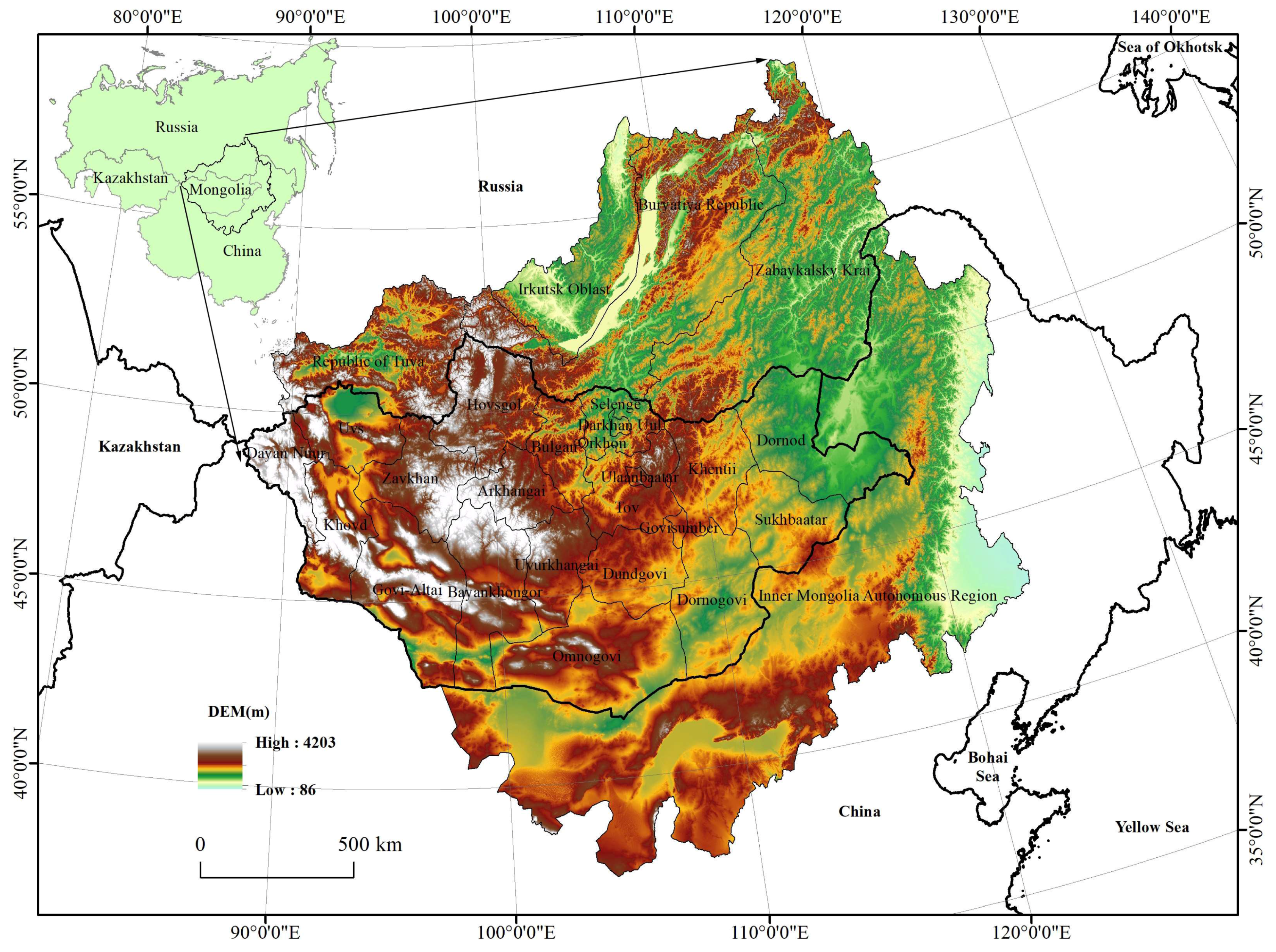


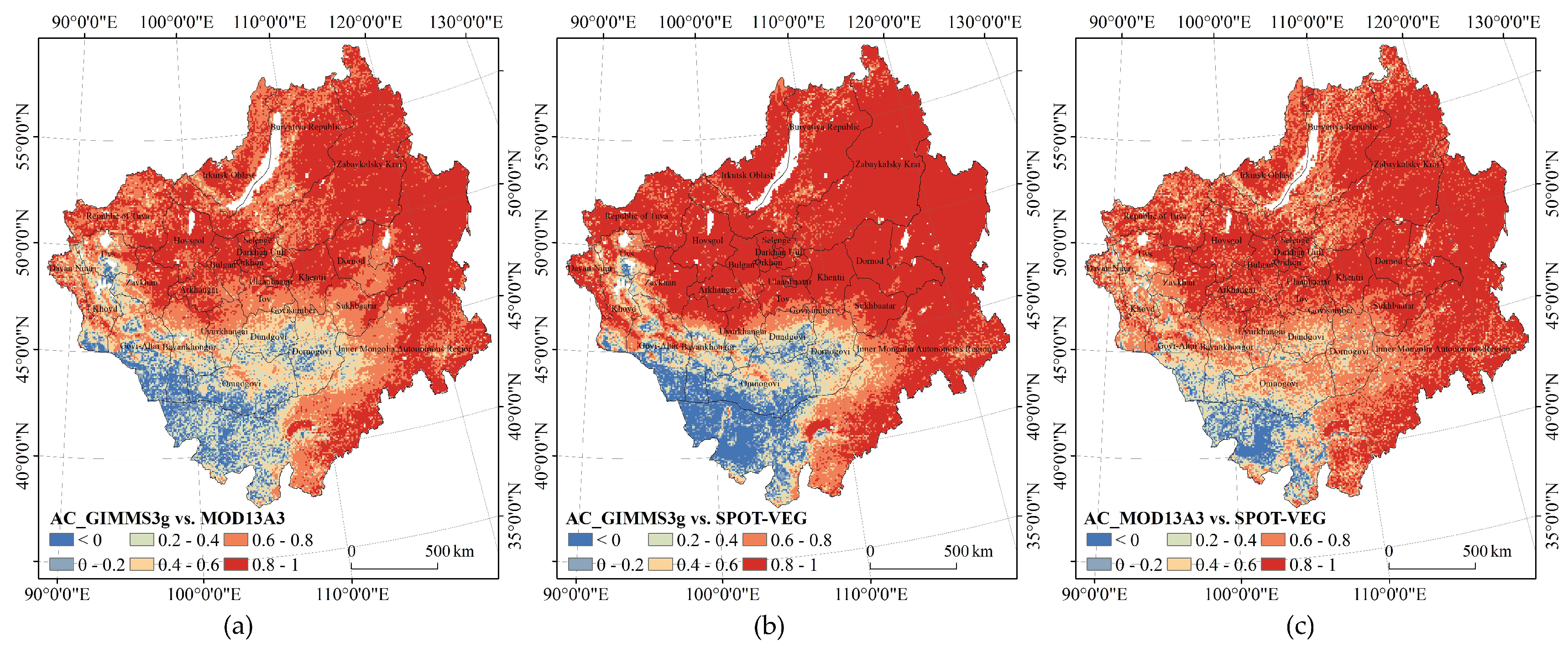
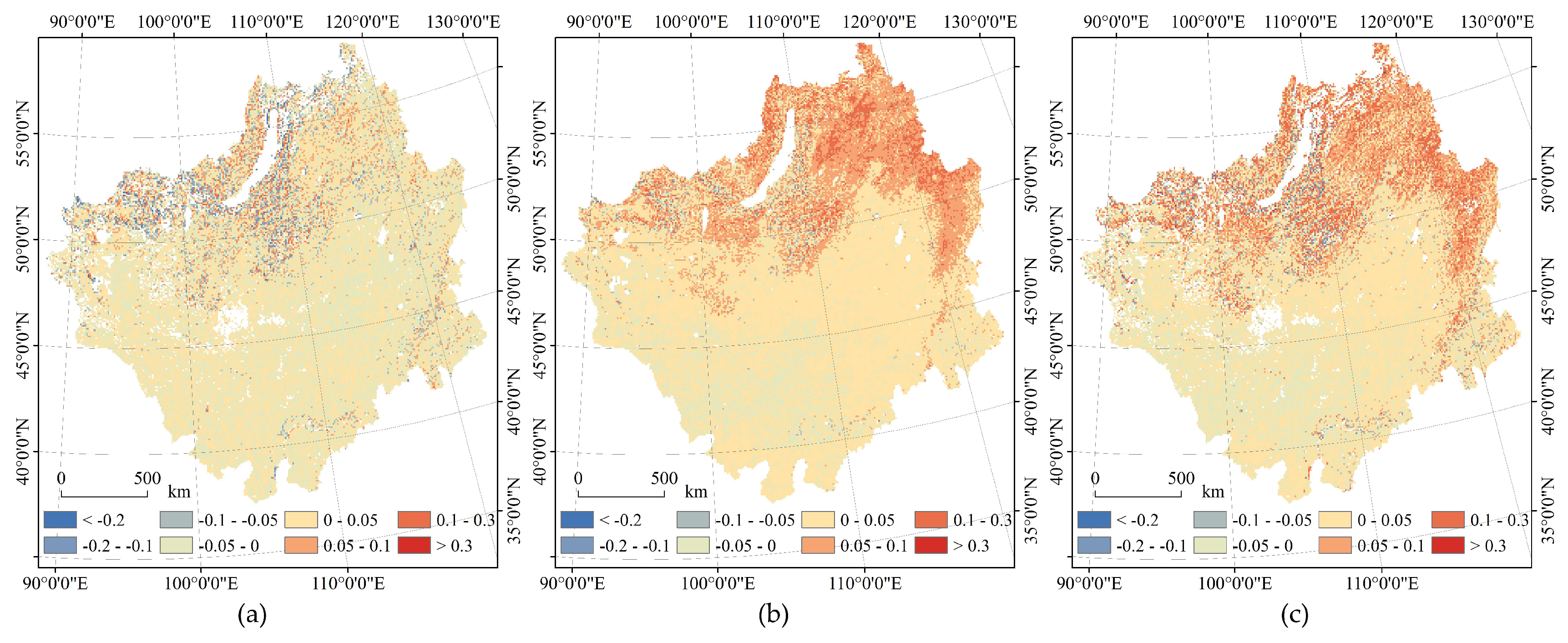
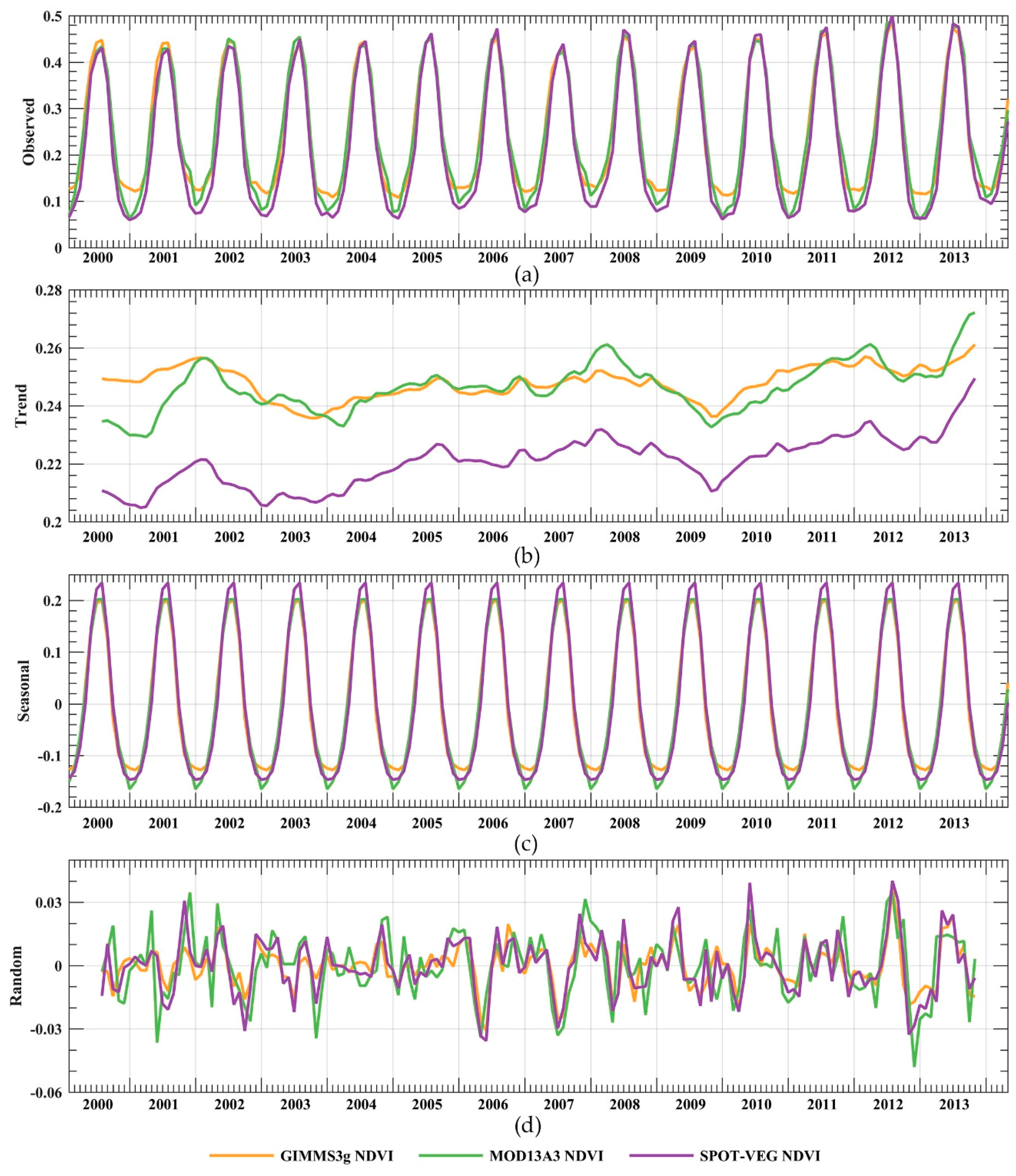
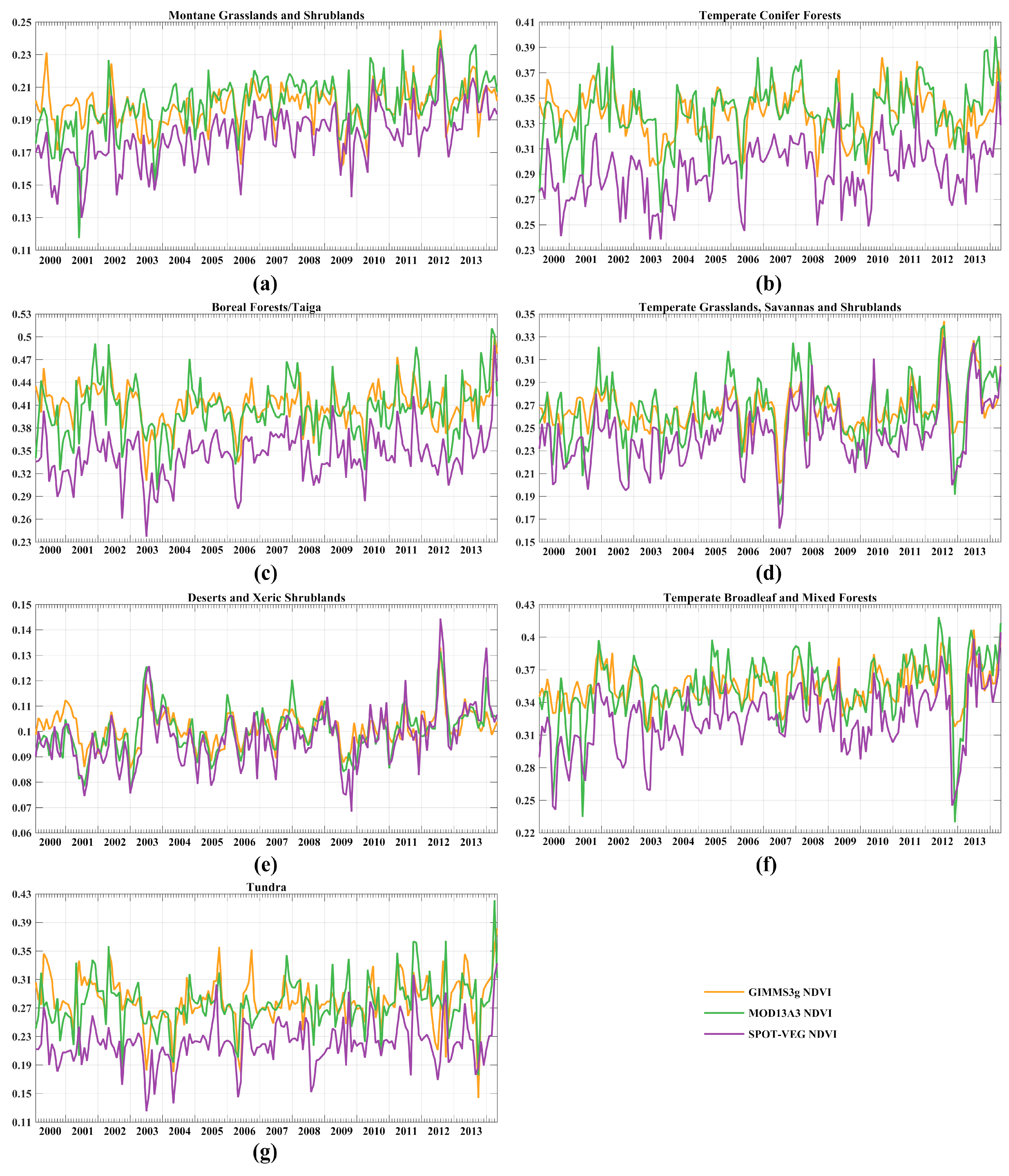



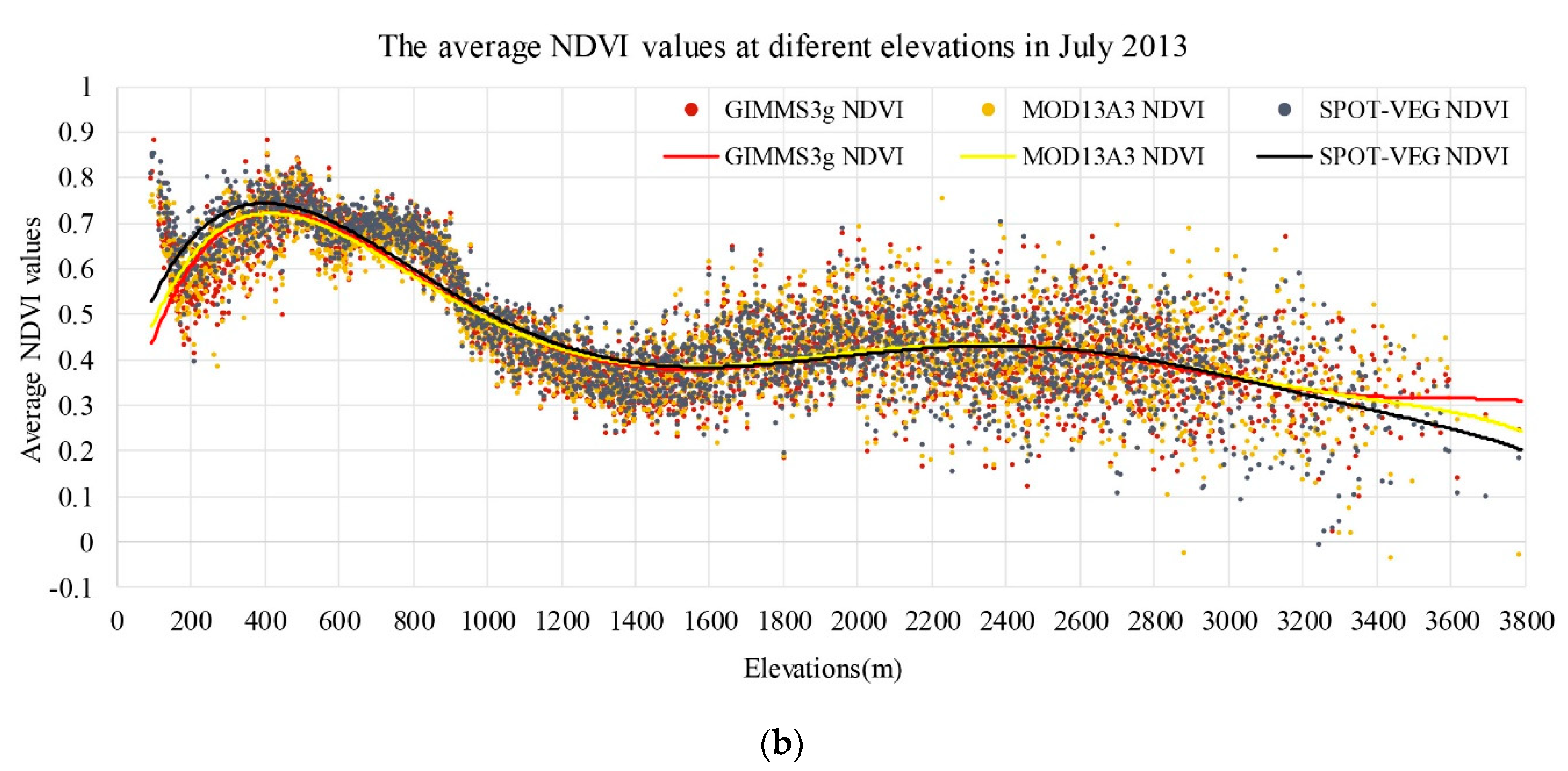
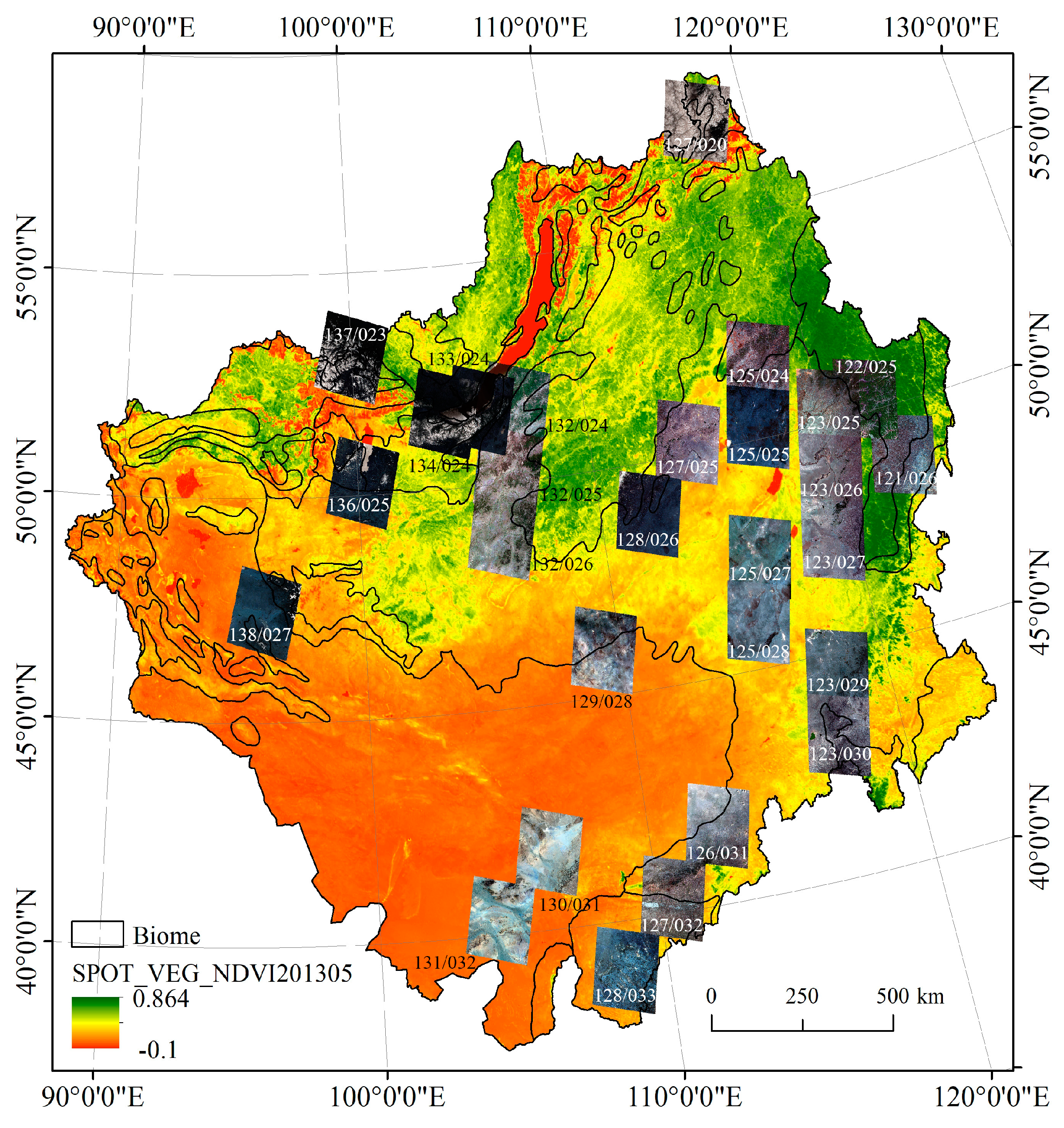
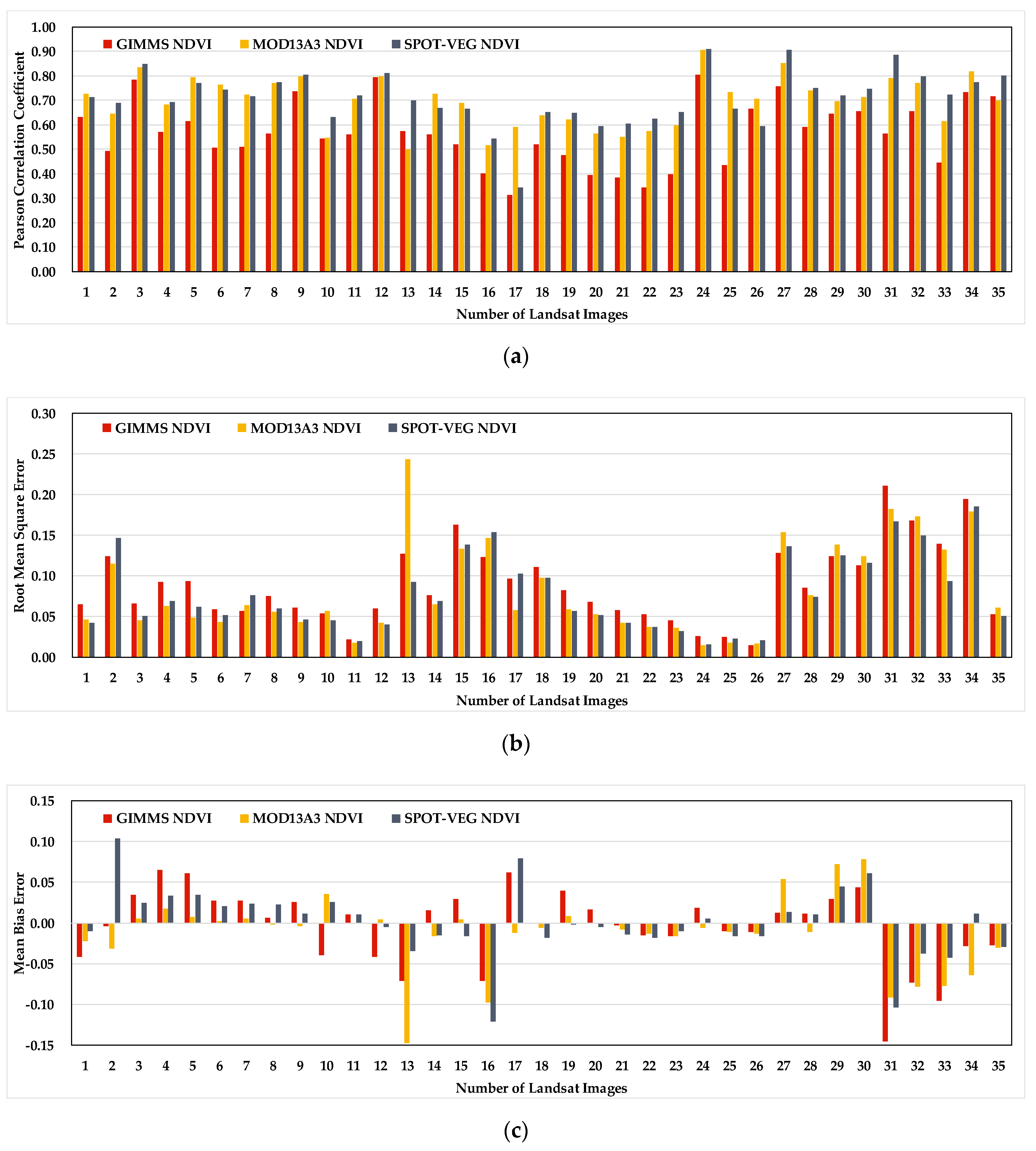
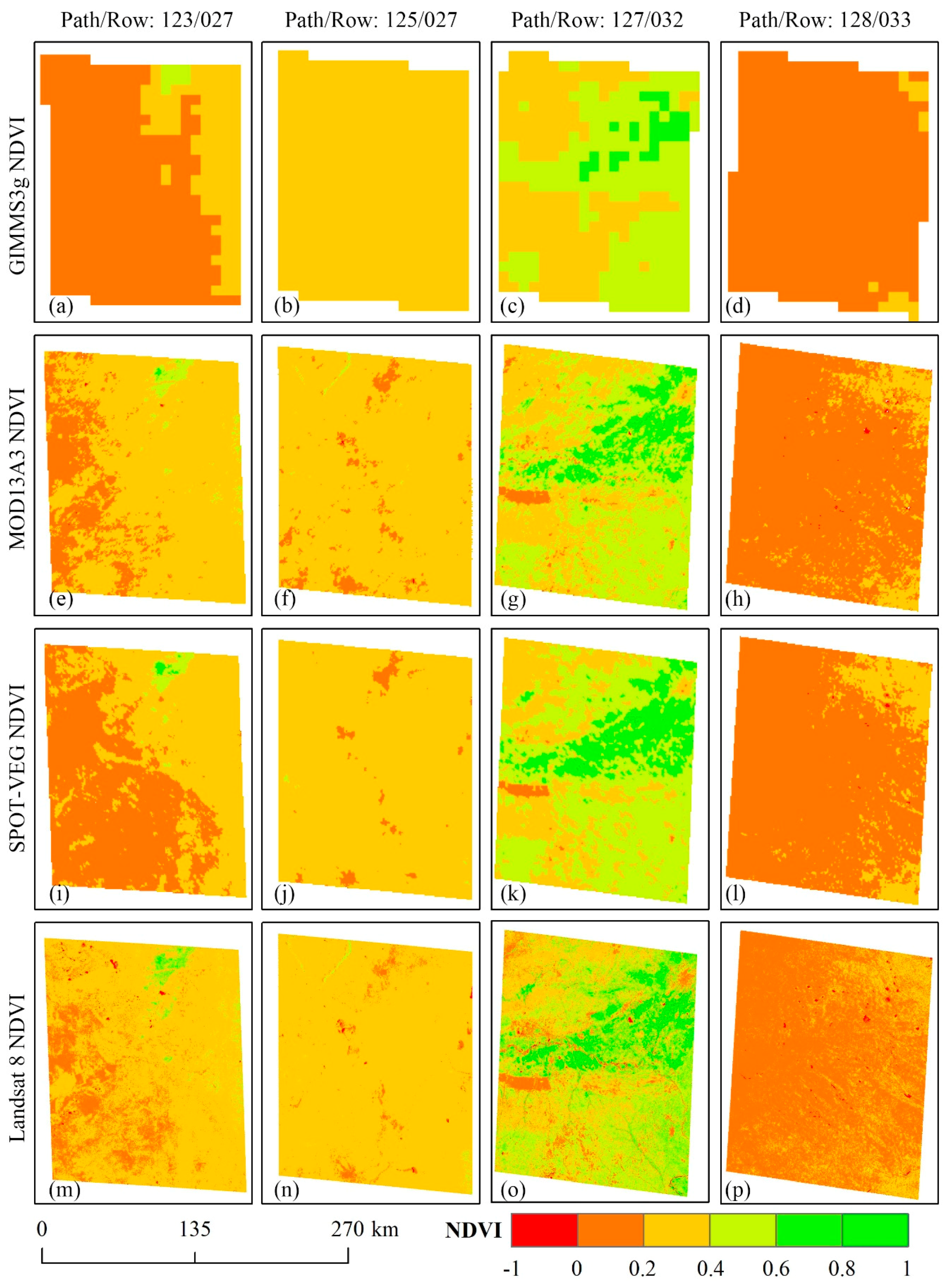
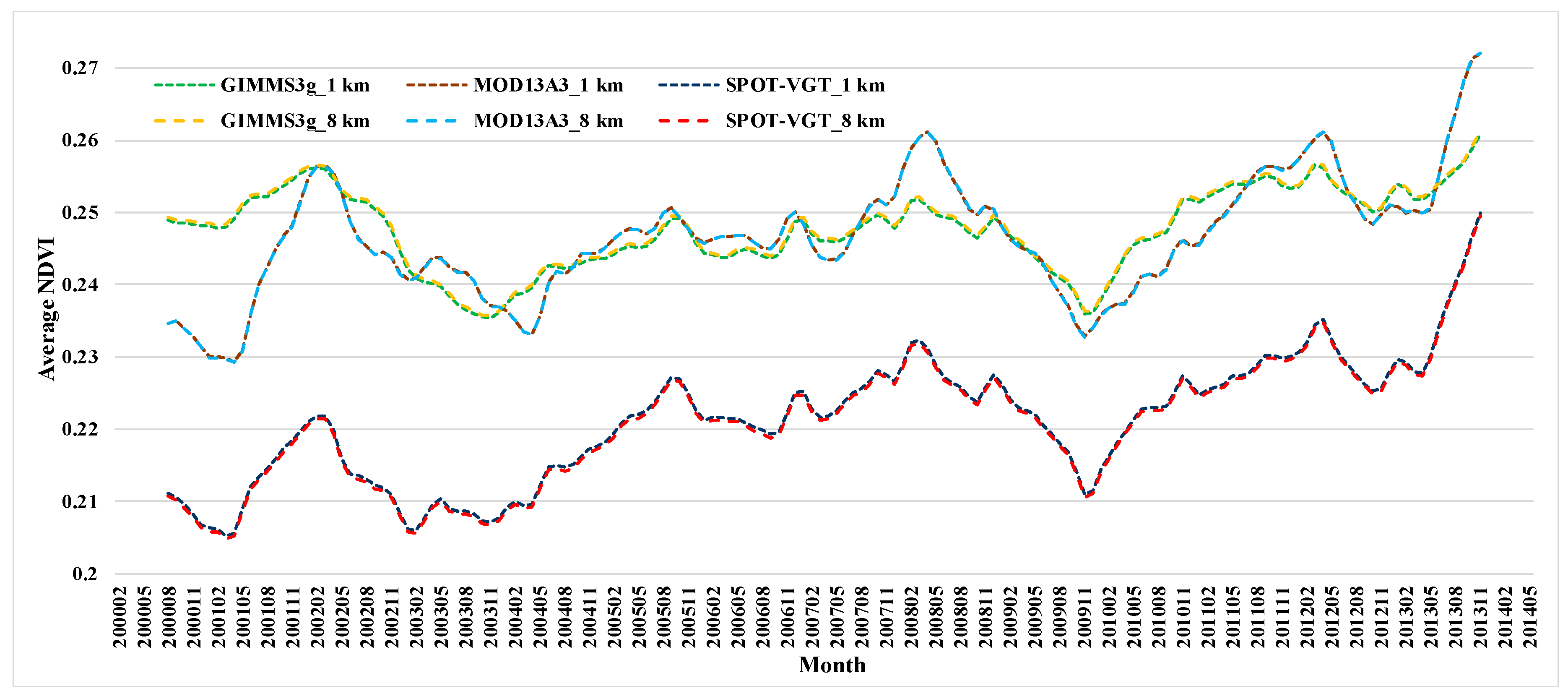
| NDVI Products | GIMMS3g NDVI | MOD13A3 NDVI | SPOT-VGT NDVI |
|---|---|---|---|
| Satellite | NOAA-16 NOAA-17 NOAA-18 | TERRA | SPOT-4 SPOT-5 |
| Sensor | AVHRR | MODIS | VEGETATION |
| Spectral range | 0.55–12.5 µm | 0.4–14.4 µm | 0.43–1.75 µm |
| Number of bands | 5 | 36 | 5 |
| Bandwidth | RED: 0.585–0.680 µm NIR: 0.730–0.980 µm | RED: 0.620–0.670 µm NIR: 0.841–0.876 µm | RED: 0.61–0.68 µm NIR: 0.79–0.89 µm |
| Radiometric resolution | 8 bits | 12 bits | 8 bits |
| Ground resolution | Primary image: 1.1 km GIMMS3g.v1 NVDI: 1/12 degree | Primary image: 250 m MOD13A3 NDVI: 926.625 m | Primary image: 1.15 km SPOT-VGT NDVI: 950.469 m |
| Temporal resolution | 15 days | 1 month | 10 days |
| Swath width | 2800 km | 2330 km | 60 km |
| Frequency of visit | 0.5 day | 16 days | 26 days |
| Overpass time | 10:15 14:00 | 10:35 | 10:30 |
| Resampling method used in this work | —— | Bilinear | Bilinear |
| Temporal compositing method used in this work | Average of two 15-day images | Weighted temporal average of MOD13A2 images | Average of three 10-day images |
| Land Cover Codes | Description of Various Land Cover Types |
|---|---|
| 11 | Post-flooding or irrigated croplands (or aquatic) |
| 14 | Rainfed croplands |
| 20 | Mosaic cropland (50–70%)/vegetation (grassland/shrubland/forest) (20–50%) |
| 30 | Mosaic vegetation (grassland/shrubland/forest) (50–70%)/cropland (20–50%) |
| 40 | Closed to open (>15%) broadleaved evergreen or semi-deciduous forest (>5 m) |
| 50 | Closed (>40%) broadleaved deciduous forest (>5 m) |
| 60 | Open (15–40%) broadleaved deciduous forest/woodland (>5 m) |
| 70 | Closed (>40%) needleleaved evergreen forest (>5 m) |
| 90 | Open (15–40%) needleleaved deciduous or evergreen forest (>5 m) |
| 100 | Closed to open (>15%) mixed broadleaved and needleleaved forest (>5 m) |
| 110 | Mosaic forest or shrubland (50–70%)/grassland (20–50%) |
| 120 | Mosaic grassland (50–70%)/forest or shrubland (20–50%) |
| 130 | Closed to open (>15%) (broadleaved or needleleaved, evergreen or deciduous) shrubland (<5 m) |
| 140 | Closed to open (>15%) herbaceous vegetation (grassland, savannas, or lichens/mosses) |
| 150 | Sparse (<15%) vegetation |
| 160 | Closed to open (>15%) broadleaved forest regularly flooded (semi-permanently or temporarily)—fresh or brackish water |
| 170 | Closed (>40%) broadleaved forest or shrubland permanently flooded—saline or brackish water |
| 180 | Closed to open (>15%) grassland or woody vegetation on regularly flooded or waterlogged soil—fresh, brackish, or saline water |
| 190 | Artificial surfaces and associated areas (urban areas >50%) |
| 200 | Bare areas |
| 210 | Water bodies |
| 220 | Permanent snow and ice |
| 230 | No data (burnt areas, clouds, …) |
| Biome Name | GIMMS3g vs. MOD13A3 | GIMMS3g vs. SPOT-VGT | MOD13A3 vs. SPOT-VG | |||||||||
|---|---|---|---|---|---|---|---|---|---|---|---|---|
| Maximum | Minimum | Mean | STD | Maximum | Minimum | Mean | STD | Maximum | Minimum | Mean | STD | |
| Montane Grasslands and Shrublands | 0.95 | −0.27 | 0.75 | 0.14 | 0.97 | −1.87 | 0.80 | 0.16 | 0.95 | −1.54 | 0.75 | 0.18 |
| Temperate Conifer Forests | 0.95 | −1.07 | 0.76 | 0.18 | 0.98 | −0.40 | 0.84 | 0.16 | 0.95 | −1.49 | 0.76 | 0.16 |
| Boreal Forests/Taiga | 0.94 | 0.16 | 0.81 | 0.09 | 0.98 | 0.20 | 0.88 | 0.07 | 0.94 | −0.30 | 0.80 | 0.11 |
| Temperate Grasslands, Savannas, and Shrublands | 0.95 | −0.28 | 0.80 | 0.10 | 0.98 | 0.12 | 0.87 | 0.08 | 0.95 | −0.40 | 0.83 | 0.09 |
| Deserts and Xeric Shrublands | 0.95 | −4.64 | 0.28 | 0.46 | 0.97 | −6.18 | 0.17 | 0.70 | 0.96 | −3.81 | 0.46 | 0.44 |
| Temperate Broadleaf and Mixed Forests | 0.96 | 0.14 | 0.86 | 0.07 | 0.98 | 0.51 | 0.89 | 0.06 | 0.96 | −1.09 | 0.86 | 0.10 |
| Tundra | 0.93 | 0.44 | 0.81 | 0.07 | 0.97 | 0.03 | 0.85 | 0.11 | 0.95 | 0.09 | 0.78 | 0.13 |
| Biome Name | GIMMS3g vs. MOD13A3 | GIMMS3g vs. SPOT-VGT | MOD13A3 vs. SPOT-VG | |||||||||
|---|---|---|---|---|---|---|---|---|---|---|---|---|
| Maximum | Minimum | Mean | STD | Maximum | Minimum | Mean | STD | Maximum | Minimum | Mean | STD | |
| Montane Grasslands and Shrublands | 0.21 | −0.27 | 0.00 | 0.04 | 0.22 | −0.17 | 0.02 | 0.03 | 0.36 | −0.20 | 0.02 | 0.05 |
| Temperate Conifer Forests | 0.31 | −0.34 | 0.00 | 0.06 | 0.23 | −0.25 | 0.05 | 0.05 | 0.40 | −0.37 | 0.05 | 0.07 |
| Boreal Forests/Taiga | 0.29 | −0.32 | 0.01 | 0.06 | 0.22 | −0.21 | 0.07 | 0.04 | 0.43 | −0.28 | 0.06 | 0.07 |
| Temperate Grasslands, Savannas, and Shrublands | 0.25 | −0.30 | 0.00 | 0.03 | 0.17 | −0.15 | 0.02 | 0.03 | 0.30 | −0.31 | 0.02 | 0.04 |
| Deserts and Xeric Shrublands | 0.17 | −0.29 | 0.00 | 0.02 | 0.15 | −0.14 | 0.00 | 0.01 | 0.31 | −0.21 | 0.00 | 0.02 |
| Temperate Broadleaf and Mixed Forests | 0.13 | −0.17 | 0.00 | 0.03 | 0.12 | −0.05 | 0.03 | 0.03 | 0.19 | −0.13 | 0.03 | 0.04 |
| Tundra | 0.18 | −0.21 | -0.01 | 0.06 | 0.20 | −0.11 | 0.06 | 0.04 | 0.30 | −0.26 | 0.07 | 0.06 |
| Biome Region | GIMMS3g NDVI | MOD13A3 NDVI | SPOT-VGT NDVI | |||
|---|---|---|---|---|---|---|
| STD | Slope/10a | STD | Slope/10a | STD | Slope/10a | |
| Total MP | 0.0119 | 5.19E-03 | 0.0181 | 1.44E-02 | 0.0174 | 1.95E-02 |
| Montane Grasslands and Shrublands | 0.0130 | 8.72E-03 | 0.0168 | 2.05E-02 | 0.0169 | 2.44E-02 |
| Temperate Conifer Forests | 0.0182 | 4.08E-04 | 0.0230 | 1.57E-02 | 0.0224 | 1.90E-02 |
| Boreal Forests/Taiga | 0.0263 | 2.36E-03 | 0.0360 | 1.50E-02 | 0.0324 | 2.26E-02 |
| Temperate Grasslands, Savannas, and Shrublands | 0.0186 | 9.91E-03 | 0.0287 | 1.79E-02 | 0.0276 | 2.48E-02 |
| Deserts and Xeric Shrublands | 0.0069 | 2.32E-03 | 0.0091 | 7.08E-03 | 0.0113 | 1.03E-02 |
| Temperate Broadleaf and Mixed Forests | 0.0170 | 9.70E-03 | 0.0295 | 2.50E-02 | 0.0287 | 2.83E-02 |
| Tundra | 0.0338 | 1.45E-03 | 0.0343 | 1.77E-02 | 0.0314 | 1.79E-02 |
| Number | Path/Row | Image Date | Number | Path/Row | Image Date |
|---|---|---|---|---|---|
| 1 | 121/026 | 2014-04-15 | 19 | 128/033 | 2014-03-15 |
| 2 | 122/025 | 2014-05-24 | 20 | 128/033 | 2013-08-03 |
| 3 | 123/025 | 2014-04-29 | 21 | 128/033 | 2013-10-06 |
| 4 | 123/026 | 2014-04-29 | 22 | 128/033 | 2013-11-07 |
| 5 | 123/027 | 2014-04-29 | 23 | 128/033 | 2013-12-09 |
| 6 | 123/029 | 2014-04-29 | 24 | 129/028 | 2014-04-23 |
| 7 | 123/030 | 2014-04-29 | 25 | 130/031 | 2014-03-13 |
| 8 | 125/024 | 2014-04-27 | 26 | 131/032 | 2014-03-20 |
| 9 | 125/025 | 2014-04-27 | 27 | 132/024 | 2014-05-30 |
| 10 | 125/027 | 2014-05-29 | 28 | 132/025 | 2014-04-28 |
| 11 | 125/028 | 2014-04-27 | 29 | 132/025 | 2014-05-30 |
| 12 | 126/031 | 2014-05-20 | 30 | 132/026 | 2014-05-30 |
| 13 | 127/020 | 2014-04-09 | 31 | 133/024 | 2014-05-05 |
| 14 | 127/025 | 2013-10-15 | 32 | 134/024 | 2014-04-26 |
| 15 | 127/032 | 2013-08-12 | 33 | 136/025 | 2014-05-10 |
| 16 | 127/032 | 2013-09-29 | 34 | 137/023 | 2014-05-17 |
| 17 | 128/026 | 2014-03-31 | 35 | 138/027 | 2014-05-08 |
| 18 | 128/033 | 2014-01-26 |
| Land Cover Types | Mean Correlation Coefficient | Mean RMSE | Mean MBE | ||||||
|---|---|---|---|---|---|---|---|---|---|
| GIMMS3g | MOD13A3 | SPOT-VGT | GIMMS3g | MOD13A3 | SPOT-VGT | GIMMS3g | MOD13A3 | SPOT-VGT | |
| Forest | 0.6056 | 0.7112 | 0.7226 | 0.2147 | 0.1503 | 0.1422 | −0.0561 | −0.0722 | −0.0758 |
| Grassland | 0.5009 | 0.6620 | 0.6674 | 0.0781 | 0.0613 | 0.0687 | −0.0070 | −0.0047 | −0.0272 |
| Cropland | 0.6342 | 0.7371 | 0.7696 | 0.1612 | 0.1128 | 0.1085 | −0.0106 | 0.0161 | −0.0511 |
| Bare/sandy land | 0.5975 | 0.7603 | 0.7068 | 0.0358 | 0.0275 | 0.0348 | −0.0137 | −0.0152 | −0.0254 |
© 2019 by the authors. Licensee MDPI, Basel, Switzerland. This article is an open access article distributed under the terms and conditions of the Creative Commons Attribution (CC BY) license (http://creativecommons.org/licenses/by/4.0/).
Share and Cite
Bai, Y.; Yang, Y.; Jiang, H. Intercomparison of AVHRR GIMMS3g, Terra MODIS, and SPOT-VGT NDVI Products over the Mongolian Plateau. Remote Sens. 2019, 11, 2030. https://doi.org/10.3390/rs11172030
Bai Y, Yang Y, Jiang H. Intercomparison of AVHRR GIMMS3g, Terra MODIS, and SPOT-VGT NDVI Products over the Mongolian Plateau. Remote Sensing. 2019; 11(17):2030. https://doi.org/10.3390/rs11172030
Chicago/Turabian StyleBai, Yongqing, Yaping Yang, and Hou Jiang. 2019. "Intercomparison of AVHRR GIMMS3g, Terra MODIS, and SPOT-VGT NDVI Products over the Mongolian Plateau" Remote Sensing 11, no. 17: 2030. https://doi.org/10.3390/rs11172030
APA StyleBai, Y., Yang, Y., & Jiang, H. (2019). Intercomparison of AVHRR GIMMS3g, Terra MODIS, and SPOT-VGT NDVI Products over the Mongolian Plateau. Remote Sensing, 11(17), 2030. https://doi.org/10.3390/rs11172030





